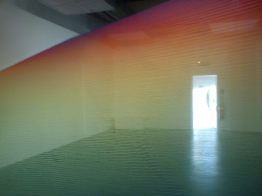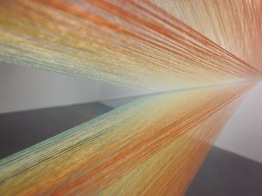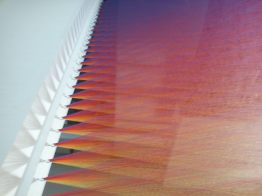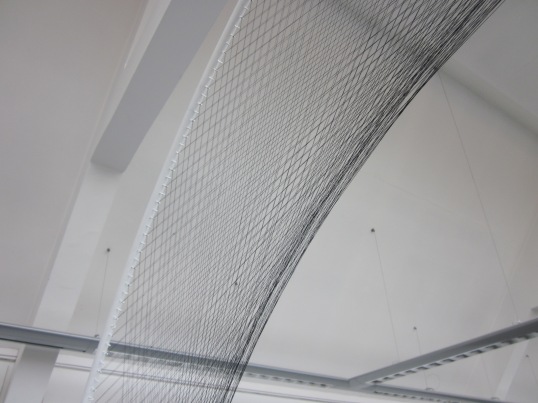I began by brainstorming different forms that are currently in existence that can be moved through, such as; doors, archways, tunnels, trees, climbing frames, spider webs. Whilst doing this I was reminded of artist Eva Schjølberg’s work I viewed at the Cultex exhibition. Another artist who has created work made up of a series of white tunnels or ‘hallways’ is Alfred Hitchcock.
Eva Schjølberg is part of a collaborative group called Cultex. Their work is influenced by the rich culture found in countries like Japan and China. I found Schjølberg’s tunnels, made out of textiles, easily guided you through the different areas of the exhibition. I feel the use of soft, white fabric to construct the tunnels reduces the sense of claustrophobia. I intend to use an element of textiles in my own sculpture, as the delicacy of the material is more inviting and should increase people’s urge to move through it.
Of the different structures that could be moved through, I found one of the most interesting to be a spider web: a form within nature, consisting of geometric, repeating patterns; an almost invisible structure, composed of delicate threads that gain solidity through complexity. I felt that by using that as my stimulus I would be able to experiment more with scale and incorporate elements of pattern into my sculpture. Lara Schnitger is one artist who has produced work in a similar style to this.
Lara Schnitger’s aim was to create a way to section off different areas of the exhibition so that people could only look at one piece of artwork at a time. I find her work very interesting as she has produced a spider web style sculpture but has approached it from a contrasting perspective of blocking people’s path. I intend for my own work to navigate people through the space as they move through it.
I thought about the different ways I could use textiles in my work and one of the most interesting I found was through the use of threads. Most people imagine a sculpture you can move through as being an architectural installation produced on a large-scale, often outside, using more robust materials. So by using thread for the construction it is rather contrasting, as it is a smaller, finer medium more suited to a sculptural installation within an art gallery.
I began to experiment with the different types of shapes and patterns I could make using thread.
Afterwards, I noticed that these had a strong link to spirograph patterns.
I have decided to take my thread based, spirograph designs and use them to form a tunnel-like structure for people to walk through. Looking at different designs that create an arch shape, I have analysed how each design will affect the scale of the piece so that the arch is suitable for people to walk through.

The design was selected based on the height of the arch and overall structure; taking into consideration the limitations set by the indoor location I plan to present it in, and the amount of design that is visible so the feature does not become insignificant.
Here is a 3D mock-up of my design to the scale 1:6. I have explored the layout of the threads running between the entrance and exit to form the tunnel. My aim was to force the tunnel to decrease and then increase in height so that people had to duck as they navigated their way through it. Also, this would visually create additional length to the tunnel as it would add lines of perspective.
I experimented with allowing the threads to cross by staggering them to create fixed points, where the tunnel became narrower. Unfortunately the construction of this caused a large section of the exit to become blocked off and having multiple points of perspective resulted in some of the depth to be lost.
I have amended the design so that it creates a natural parabolic curve and focuses on one central point of perspective.
“Introducing Gabriel Dawe” – Plexus No. 10: Materialising the Structure of Light.
Gabriel Dawe’s large-scale structures using a network of threads shows the spectrum of colours visible when a ray of white light is shone through a prism. I found his installation rather inviting as you walked through the guided paths of disorienting colour and line. Dawe’s use of thread within his work is very controversal as it rebels against the traditional perceptions of “women’s work”.
I had a feeling of peace and serenity as I walked through Dawe’s exhibition. The smooth flowing lines created by the threads made it a very tranquil environment.
I found Dawe’s work very similar to my own ideas for my sculpture. Both large-scale sculptures are produced by the intricate layout of thousands of metres of thread. One difference is that I don’t plan to use a series of different coloured threads. The focus of my sculpture is on the design created by the threads so multiple colours would detract from this whereas Dawe’s focus is on the creation of a wall of an array of colour. The use of numerous threads from each hook to gives his structure a solid appearance which is rather inspiring. I may try to incorporate a similar technique between the entrance and exit archway so that it creates an enclosed feeling within the tunnel.
Tamar Frank’s key media is coloured lights. In her recent piece ‘A thin line between space and matter’, she used phosphorescent threads to highlight detail created. The phosphorescent threads absorb light energy that is emitted slowly. This creates a colourful architectural form both delicate and intricate. The inspiration for this piece came from the shapes and spaces created by the interior of the exhibiting building. I find this architectural detail is mirrored by the medium, which offers an intensity of colour, obtained from light energy, which transcends with the darkness. This same delicacy of form has been created in Modernist works by the constructivist Naum Gabo.
I am going to make the rings of my sculpture out of white plastic pipe and screw in a series of hooks at 2cm intervals to attach the thread. I am going to fashion wooden pegs to connect the pipes together that follow the angle of the curve.
When I did bent the pipes into a circle the curve of the wooden pegs caused a gap to be created between the pieces of pipe so I had to recreate the pegs out of metal in order for the join to be streamline. This resulted in a complicated process of sandblasting, grinding, sanding, lubricating, rapid heating and cooling and pressure. To fix the pipes onto the base I created metal pegs which I then flattened and angled to the correct degree of the curve and then bolted to the base boards.
To allow the focus of the sculpture to be on the design of the threads rather than the architectural structure, I have painted the form white so that it blends in with the white walls of its surrounding.
I have selected the location of where to exhibit my sculpture very carefully. I needed to attach my sculpture to the ceiling in order to obtain the required amount of tension in the pipes to maintain its circular form. I chose an exhibition space with a high ceiling and overhead beams and built the sculpture to fit the space, enabling fishing line to be tied around the beams to help support it.
























